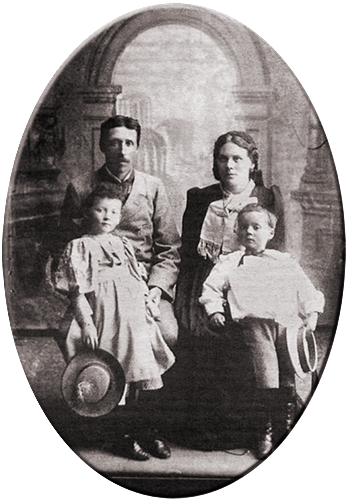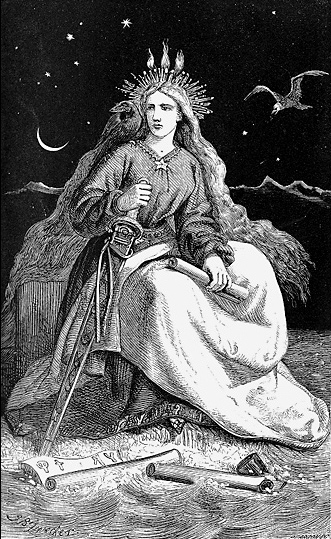Valdimar ÁsmundSson – Translator, Publisher and Co-editor of Makt Myrkranna
Valdimar Ásmundsson, Briét Bjarnhéðinsdóttir and their children Laufey (l) and Héðinn, around 1900. While the biography of the Irish writer Bram Stoker (1847-1912), the author of Dracula, by now is well researched, most people outside Iceland never heard the name of Valdimar Ásmundsson (1852-1902), who translated, published and probably co-edited Makt Myrkranna – although in his home country, his name is well known and highly respected. Our upcoming translation will, of course, also contain a chapter about Valdimar's life. A few things can already be told here. Valdimar grew up in very simple circumstances in the north of Iceland. He visited neither high school nor university. Although some learned men who knew him as a boy and young man noticed his extraordinary talents, he preferred to teach himself English, German and French, next to Norwegian, Swedish and Danish, plus some Latin and Greek. He also managed to get a solid knowledge of the Natural Sciences. He became a teacher and wrote a grammar book of the Icelandic language. For the publisher Sigurður Kristjánsson he created a very popular edition of the Icelandic sagas in 38 volumes. He was very familiar with these tales from the 12th, 13th and 14th centuries; in fact, it was believed that no one in Iceland knew so much about old Icelandic books as Valdimar. This is quite a compliment, as the Icelanders are very proud of their unique collection of literature. Because of this expertise, Valdimar even became an advisor to the Icelandic Parliament, the "Alþingi", because many decisions taken in medieval times about the borders between single properties were documented in these ancient handwritings. Eventually, Valdimar moved to Reykjavík, the country's capital. Together with Sigurður Kristjánsson, he founded the newspaper (or magazine - it appeared only twice a month) Fjallkonan. The name is derived from a symbolical character, the "Lady of the Mountains", who represented the authentic and independent Icelandic nation which Valdimar and his wife Briét Bjarnhéðinsdóttir were dreaming of; at that time, Iceland was still in a political union with Denmark. Fjallkonan also stood for a strong and free woman; Briét was one of the first women's rights activists in Iceland and publisher of the magazine Kvennablaðið (Women’s Magazine). Moreover, Briét was a teacher and for some years, she was also a member of the Reykjavík City Council. Together with Valdimar, she always supported modernization, like electric street lighting in the city and university education for women. Their daughter, Laufey, was the first woman in Iceland to enter university. She and her younger brother Héðinn later also engaged in social and feminist issues. 
Fjallkonan character by Johann B. Zwecke, 1866. By the end of 1885, Valdimar - already the editor of Fjallkonan - also became its owner and publisher. It became one of the most successful magazines in Iceland - for some years it even was the largest - and the publication frequency was raised to once per week. It reported on the discussions in the Icelandic Parliament, often in rhyme, written by Valdimar; it commented on many political and cultural issues, summarised the news from foreign newspapers and sneered at competing magazines; moreover, there were all kinds of announcements and advertisements. In 1894, Fjallkonan published a short story by Mark Twain, a good friend of Bram Stoker. Six years later, in January 1900, the serialization of Makt Myrkranna started. Although the story, later printed in book form, was not often reviewed, the title became well-known in Iceland; it was used as a synonym for Dracula. Valdimar died on 17 April 1902, nearly exact ten years before Bram Stoker (20 April 1912). His life and death were commemorized in all Icelandic magazines, and his rhymed comments on Icelandic politics were posthumously published as a little book. Only much, much later, in 1975 and 1984, the Icelandic author Halldór Laxness, winner of the Nobel Prize for Literature, mentioned Makt Myrkranna twice in his memoirs and travelogues, since he had read the book as a child already. He called it "one of the best Icelandic stories imported from overseas", and Valdimar Ásmundsson "one of the best pens in our country". For his famous novel Christianity at the Glacier (1968), Halldór used Makt Myrkranna as a model. The Icelandic author Bjarni Bjarnason in 2004 published an essay about the parallels between Christianity at the Glacier on the one hand, Dracula on the other hand. In 2011, Ásgeir Jónsson refined this analysis and demonstrated that Halldór actually had started from Makt Myrkranna, not Dracula. Like Hans, Ásgeir had discovered the differences between the 1897 English story and the Icelandic version of 1900. With this discovery, new light is thrown on Valdimar's talents and his original contribution to Makt Myrkranna. |
|
|